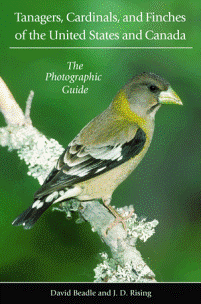Reviewed by Grant McCreary on December 9th, 2006.
Your initial impression of this book will be “Wow, this
thing is thin!” The thinness is a symptom of the issue
that plagues this guide – lack of adequate coverage. Of
all the entries to date in Princeton’s Photographic
Guide series, this one has the fewest pages. There just
aren’t enough photos. This guide has the same number of
photographs as the Hummingbird Photographic Guide in
the same series. However, the Hummingbird guide has 62
more pages and covers 22 fewer species!
To make the issue worse, the pages that are included are not used optimally. Many pages have room for more photographs, but do not utilize it. The account for the Crimson-collared Grosbeak is such an example. This is a sexually dimorphic species that is a very rare visitor to Texas. The book presents you with only one very poor quality photo of a female. However, the page has room for two more standard-sized photographs! During the irruptive winter of 2004-05 several of these grosbeaks were found in the Lower Rio Grande Valley. A birder I know took some amazing photos of one of the males. The red and black coloring was exquisite and put to shame the illustrations of the bird in the field guides I had seen (including Sibley, which is no mean feat!). Thus it is very disappointing that the only illustration of this bird in the guide is a poor representation of the duller-colored (but still attractive) female.
It’s not only the vagrants who get short-changed. For instance, there is not a single photo of an adult male basic (winter) Rose-breasted Grosbeak.
One bright spot is the fairly extensive treatment of the geographic variation in Red Crossbills. It even includes sonograms of the eight call types, which would be very useful if the species is ever split (the call is the most reliable way of differentiating between the Red Crossbill types). However, this info, including the sonograms, are included in the species’ Birds of North America account.
If you must have everything published on this group of birds, then by all means get this book. Otherwise, I would suggest saving your money. It must be noted, however, that every other entry that I have seen in Princeton’s Photographic Guide series is outstanding and highly recommended. Hopefully this one will continue to be the exception.
Disclosure: I get a small commission for purchases made through links in this post.



Comment